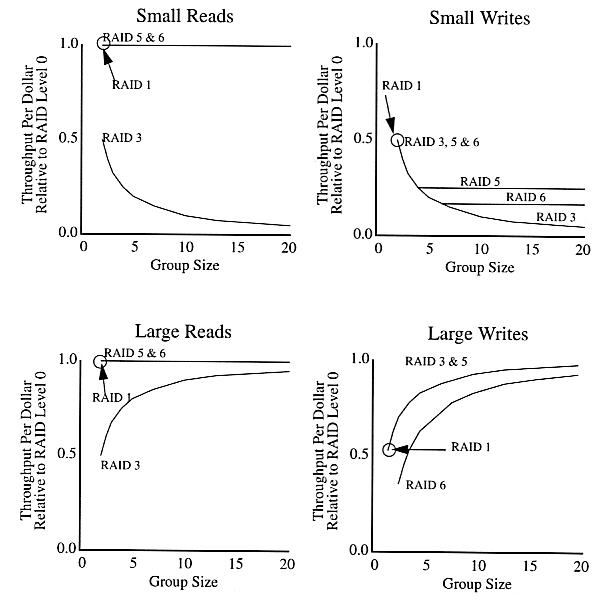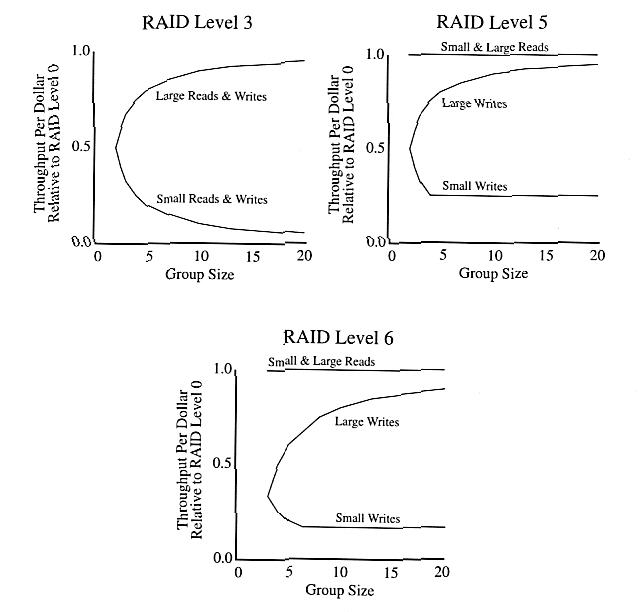 source: Reference
1
source: Reference
1
There are three important considerations while making a selection as to which RAID level is to be used for a system viz. cost, performance and reliability.
There are many different ways to measure these parameters for eg. performance could be measured as I/Os per second per dollar, bytes per second or response time. We could also compare systems at the same cost, the same total user capacity, the same performance or the same reliability. The method used largely depends on the application and the reason to compare. For example, in transaction processing applications the primary base for comparison would be I/Os per second per dollar while in scientific applications we would be more interested in bytes per second per dollar. In some heterogeneous systems like file servers both I/O per second and bytes per second may be important. Sometimes it is important to consider reliability as the base for comparison.
Taking a closer look at the RAID levels we observe that most of the levels are similar to each other. RAID level 1 and RAID level 3 disk arrays can be viewed as a subclass of RAID level 5 disk arrays. Also RAID level 2 and RAID level 4 disk arrays are generally found to be inferior to RAID level 5 disk arrays. Hence the problem of selecting among RAID levels 1 through 5 is a subset of the more general problem of choosing an appropriate parity group size and striping unit for RAID level 5 disk arrays.
Some Comparisons
Given below is a table that compares the throughput of various redundancy
schemes for four types of I/O requests. The I/O requests are basically
reads and writes which are divided into small (reads & writes) and
large ones. Remembering the fact that our data has been spread over multiple
disks (data striping), a small refers to an I/O request of one striping
unit while a large I/O request refers to requests of one full stripe (one
stripe unit from each disk in an error correcting group).
|
|
|
|
|
|
|
|
|
|
|
|
|
|
|
|
|
|
|
|
|
|
|
|
|
|
|
|
|
|
|
|
|
|
|
|
|
|
|
|
|
|
G : The number of disks in an error correction group.
The table above tabulates the maximum throughput per dollar relative level 0 for RAID levels 0, 1, 3, 5 and 6. For practical purposes we consider RAID levels 2 & 4 inferior to RAID level 5 disk arrays, so we don't show the comparisons. The cost of a system is directly proportional to the number of disks it uses in the disk array. Thus the table shows us that given equivalent cost RAID level 0 and RAID level 1 systems, the RAID level 1 system can sustain half the number of small writes per second that a RAID level 0 system can sustain. Equivalently the cost of small writes is twice as expensive in a RAID level 1 system as in a RAID level 0 system.
The table also shows storage efficiency of each RAID level. The storage
efficiency is approximately inverse the cost of each unit of user capacity
relative to a RAID level 0 system. The storage
efficiency is equal to the performance/cost metric for large writes.
 source: Reference
1
source: Reference
1
The figures above graph the performance/cost metrics from the table above for RAID levels 1, 3, 5 and 6 over a range of parity group sizes. The performance/cost of RAID level 1 systems is equivalent to the performance/cost of RAID level 5 systems when the parity group size is equal to 2. The performance/cost of RAID level 3 systems is always less than or equal to the performance/cost of RAID level 5 systems. This is expected given that a RAID level 3 system is a subclass of RAID level 5 systems derived by restricting the striping unit size such that all requests access exactly a parity stripe of data. Since the configuration of RAID level 5 systems is not subject to such a restriction, the performance/cost of RAID level 5 systems can never be less than that of an equivalent RAID level 3 system. Of course such generalizations are specific to the models of disk arrays used in the above experiments. In reality, a specific implementation of a RAID level 3 system can have better performance/cost than a specific implementation of a RAID level 5 system.
The question of which RAID level to use is better expressed as more general configuration questions concerning the size of the parity group and striping unit. For a parity group size of 2, mirroring is desirable, while for a very small striping unit RAID level 3 would be suited.
The figure below plots the performance/cost metrics from the table above for RAID levels 3, 5 & 6.
 source: Reference
1
source: Reference
1